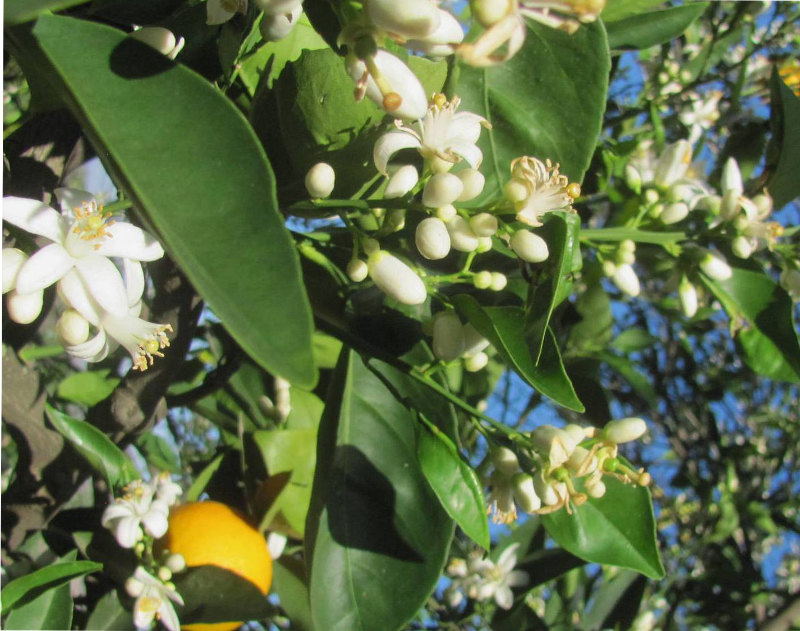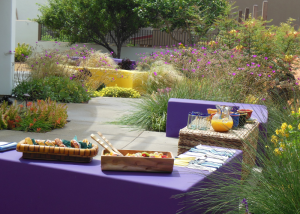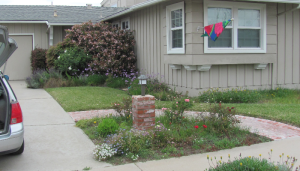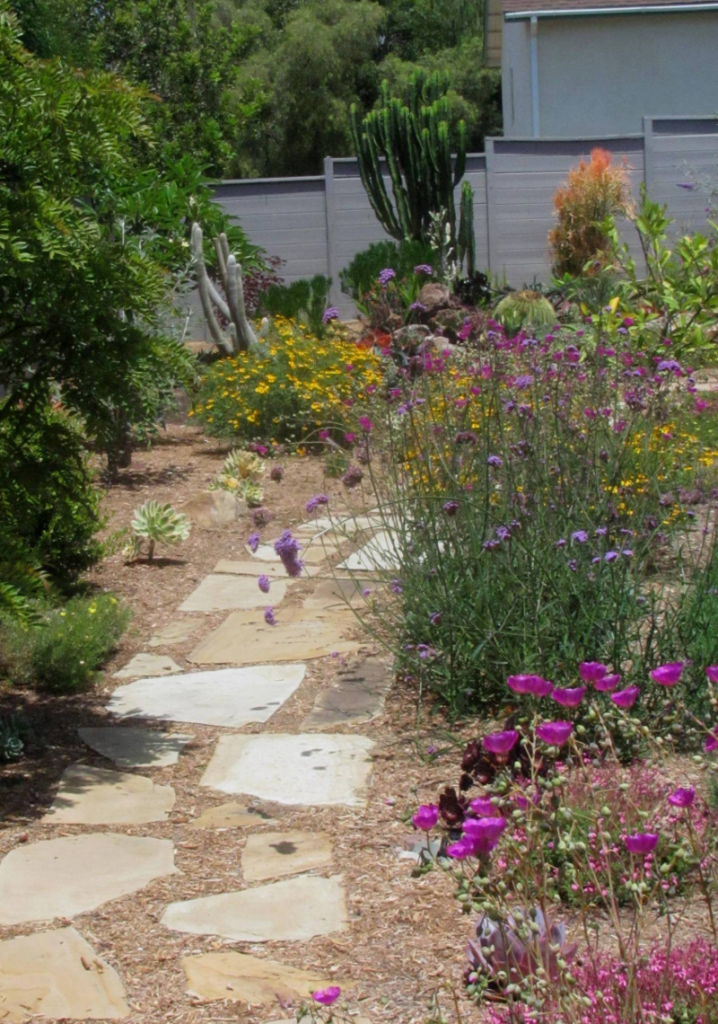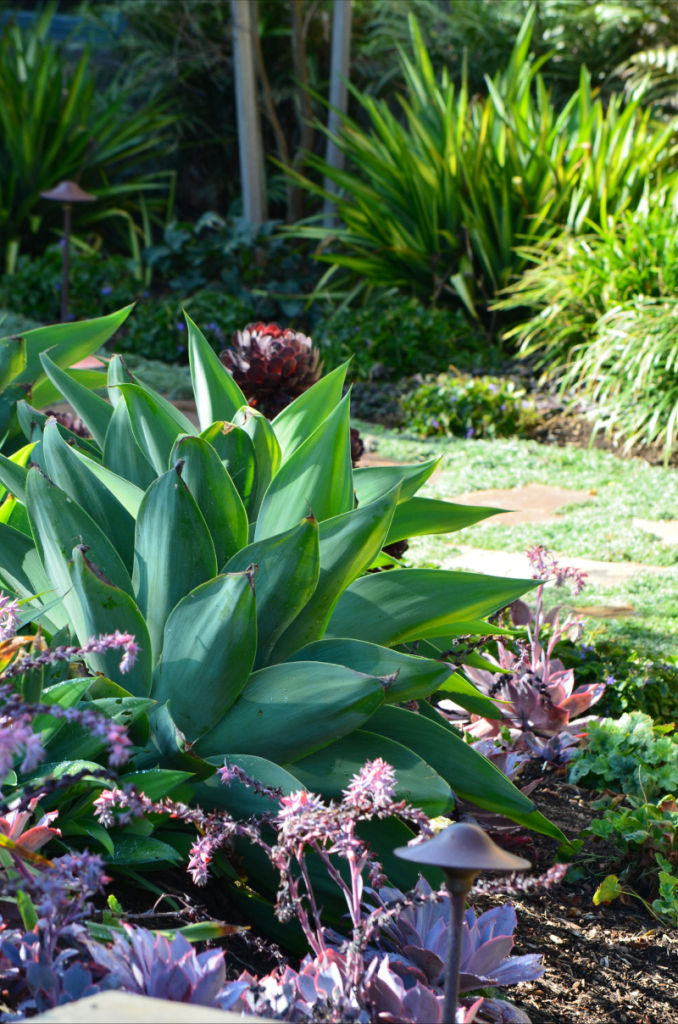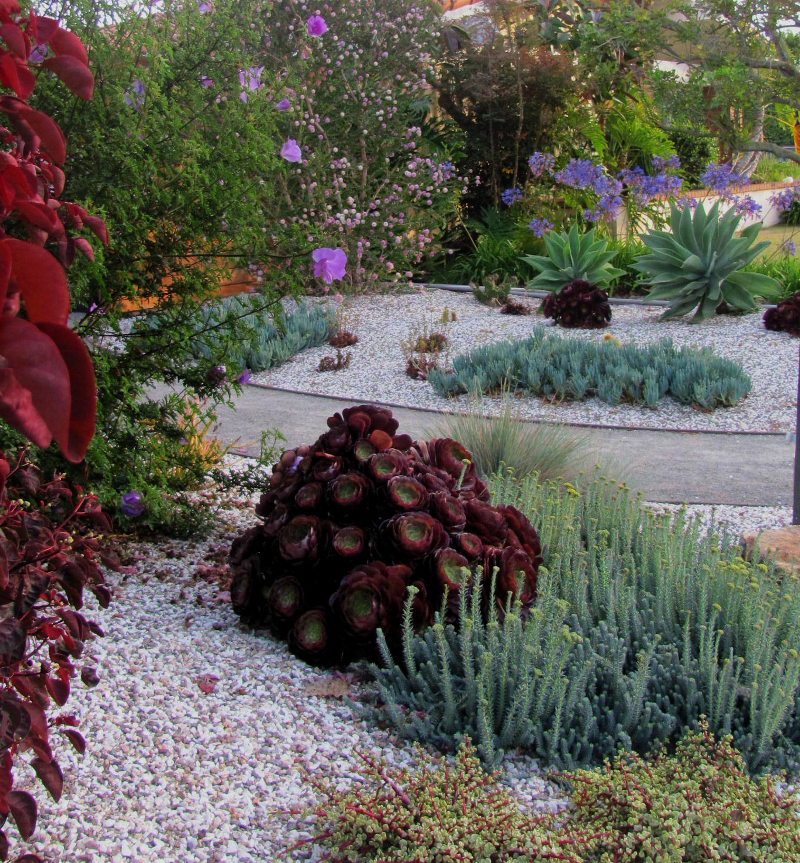
Xeriscape landscaping can be colorful, water-saving and rewarding
In my previous post, San Diego … Drought Proof Your Landscape, Part 1, I explained the term “xeriscape” and outlined several water-smart landscaping ideas and the first steps towards a water-wise landscape that is beautiful and yet sustainable. Here are the remaining steps a well as valuable resources.
5. Now that you are making voids in your garden (by eliminating certain unsustainable plants), perhaps it’s time to splurge on a few new hardscape elements (patios, walkways, shade pergolas)?
In my mind a garden is only a place worth caring for when it comes to life with plants. However, our landscapes need structure and good organization if they are to be enjoyable. And to enjoy them usually means entertainment, relaxation, rejuvenation, and also play and reconnecting with nature in the privacy of our home.
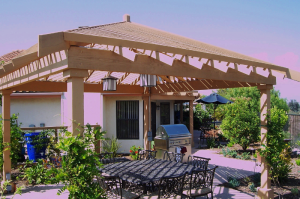
A shade cover allows daylong use of the patio
Patios, decks or terraces:
They have an immensely popular and well-deserved status in our landscape. If comfort and peace eludes you on your patio there’s no incentive to be out in the garden much…
- it needs to be big enough to be comfortable;
- it needs to be paved with safe and appealing materials;
- it needs to be sheltered from sun, wind or the curiosity of our neighbors;
- it needs to be comfortably accessible from the kitchen when food is carried outside to the dining or lounging table.
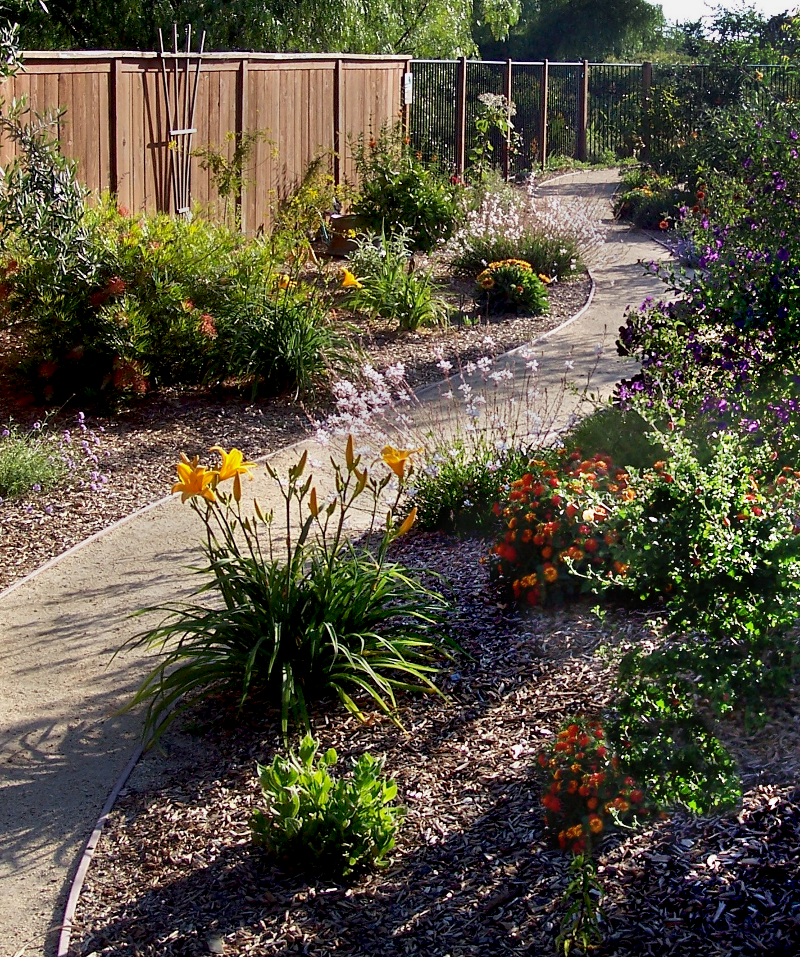
Walkways in the garden expand your enjoyment of it
If you find that any of these elements is missing from your entertainment/relaxation space, now might be the time to remedy these shortcomings and create a comfortable outdoor entertainment space design. Perhaps a new pavement is needed, or a shade device? This could be a pergola, an umbrella or shade sails, or (most practical perhaps or economical) a shade tree!
And new pathways? Imagine going on a discovery tour in your garden and enjoying your creativity, admiring what all the beautiful drought tolerant plants are showing off through the seasons. A discovery path that winds around your new planter beds, or a strolling path leading to a bench or comfortable seat at the rear end of your garden could be a long lasting addition that will pay off many-fold.
6. Mulch – too often overlooked
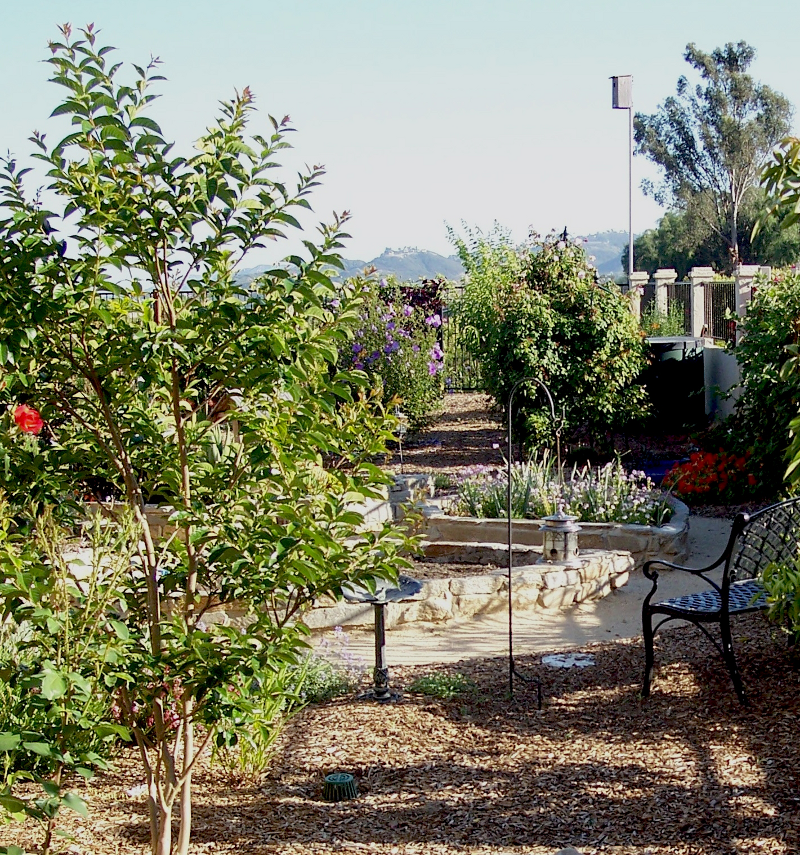
A good-looking mulch helps save water and gives it all a finished look
A thick layer of mulch, spread around all plants is so important! It should be 2-3 inches thick, or the kind that includes also small pieces (not the nuggets or the shredded lumber), and not smothering the root crown (the part where the roots converge into the stems just at/above soil level) to avoid fatal fungus disease.
A layer like this is attractive, makes your plants stand out, cools and enriches the soil, prevents erosion from rain or hard irrigation, and slows down evaporation. It’s a big water saver, and whatever has decomposed during the year, needs to be replenished in the following spring.
Some landscape are well served with an inorganic layer of mulch, made from decomposed granite or crushed rock. These materials are well suited to Southwest landscape designs or “desert-scapes”, and this type of mulch, although not enriching the soil, can help reduce evaporation and gives a finished look.
7. Know your soil
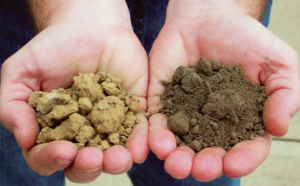
Knowing your soil texture helps determine what to plant, how to irrigate and how to amend your soil
Knowing whether you have sandy, loamy or high clay soil lets you determine whether to “condition” your soil (by adding compost, organic matter, or other ingredients such as gypsum), which irrigation system to use, how fast water drains into the sub soil and when to irrigate again. It also helps you determine which plants are best for your location. In my mind it’s not as necessary to add nutrients — most of the drought tolerant plants come from areas with nutrient-poor soil — as it is to have organic matter in your soil as this organic matter, as it decomposes, feeds more micro-organisms and creates a healthier environment for plants. So adding compost for example helps you improve your soil.
This Homeowner’s Guide to a WaterSmart Landscape Flipbook helps you determine this question.
8. Hand-watering; still a smart irrigation technique?
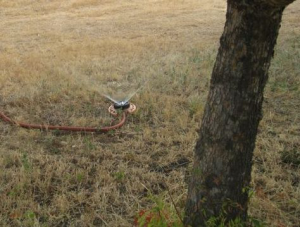
Hand-watering helps to “spot water” only the plants that you want to save
If you have a mature tree in your landscape that “never gets any (irrigation) water”, you might think you don’t need to water this specimen.
However, it’s important to consider that our winter was very dry, and that “established plants” can get by without extra water – only if they can tap into a reservoir of soil that was re-hydrated in the winter. With our meager rainfall this winter, there’s nothing much to tap into… I’d get a hose-end sprinkler device , one that you can set on the ground, at the end of your garden hose, and a simple kitchen timer, and give this so important asset in your garden a few deep soakings. It’s important to note that a tree that is stressed doesn’t show its stress right away; it might take a couple to a few years until the stress invites insect attack, tip dying, and eventual demise.
What’s deep soaking? Only a soil moisture measuring device, such as auger or soil tube, can prove that your water has sunk in deeply. For a tree that means 18 to 24 inches because in this layer of soil trees usually have about 90 % of their roots.
9. Investigate where your irrigation system might be wasting water.
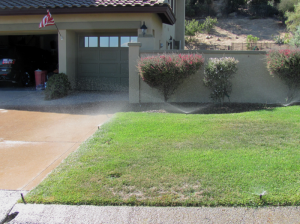
Sad thing to see so much water land on the driveway
It has been shown in numerous studies that the traditional sprinkler heads and rotors have a mere 50% efficiency rate, and you can observe in your neighborhood (if not in your own garden), how much of runs off before it can get to the plants (such on compacted turf for example, or on slopes); or how much gets blown away by the wind, or how much of lands on driveways or sidewalks.
The modern low-volume spray systems or drip are much more efficient, and water used these systems go much farther.
10. Irrigate wisely – not miserly.
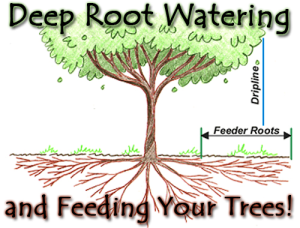
Most trees’ feeder roots are to be found in the top 18-24 inches
The word is “deep watering”, not frequent… This has to do with your plants root systems: For trees about 90% of their roots are in the top 1-2 feet; for larger shrubs a bit less, and for perennials about 6 inches. (These are very rough generalizations and can be fine-tuned depending on the plants that you want to water.)
To water a drought tolerant plant, you might think you don’t need to water much. That’s ultimately the goal, but it’s important to visualize the root system of this plant:
At planting time all the roots of this plant are in a small confined space – a 1 gal or a 5 gal pot, or larger – and if this plant is not allowed to stretch its roots out far and deep, it will never be ‘drought tolerant’! The establishment phase therefore is crucial: During this phase the water needs to be applied regularly and deeply.
To determine how long then your irrigation system needs to run, you will need to a percolation test.
11. Invest in a smart irrigation system
Not only is low-volume irrigation more efficient at watering your landscape and therefore wastes less water, it can be combined with a “smart irrigation controller”. This device is tied into weather stations (the better ones even have local sensors) that measure your local temperatures, even relative humidity, solar radiation, and water loss due to evaporation. Combined with your input of the type of plants that you want to water, your soil type and your type of irrigation system it calculates how much and when to water.
If this process is over your head, there are many local companies that offer help with this smart system. (check out the CLCA website for qualified landscape companies. Also the Irrigation Association and American Society of Irrigation Consultants)
Lastly, it’s very useful to locate any leaks or breaks that your system might have, and to do a pressure test: Pressure that’s too high can cause more wind-born water and runoff than you want to pay for…A pressure regulator can achieve valuable water savings.
Water Conservation Resources
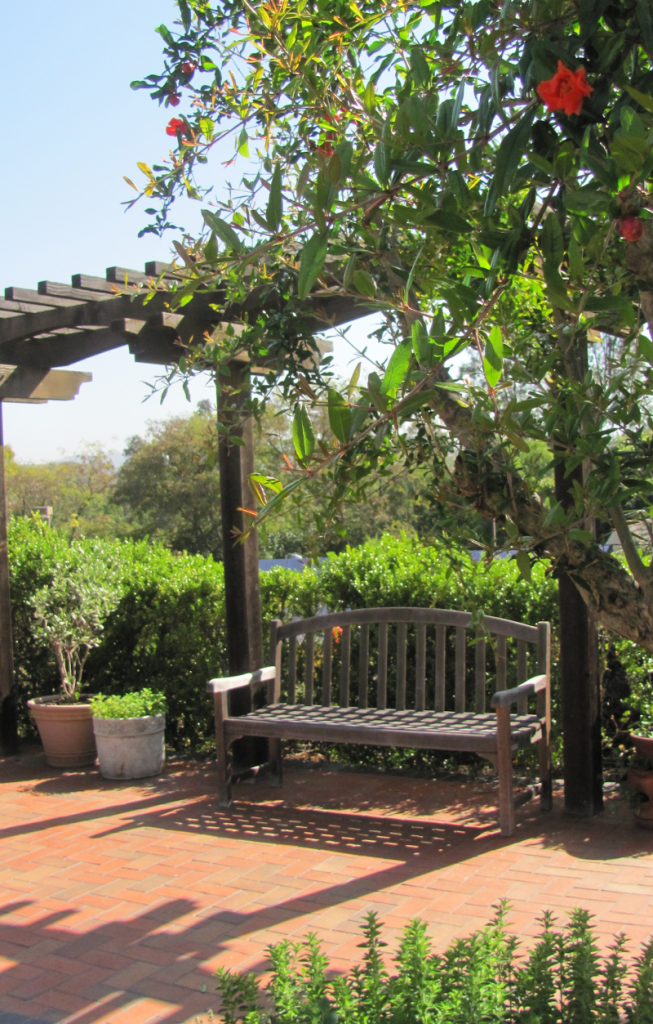
This bench invites to rest here for a while
Here an EPA overview of ‘smart sense controllers’: www.EPA.gov/WaterSense
The San Diego County Water Authority has a very useful website. It lists numerous resources related to water conservation:
www.BeWaterWise.com
To see how beautiful water-conserving plants can be, the The Water Conservation Garden’s water-wise demonstration garden is a must-visit.
The Landscape Watering Calculator computes individualized watering requirements.
The California Friendly Garden Guide searchable plant database and other useful features.
San Diego County Water Authority 20-Gallon Challenge information.
On this website you’ll also find more educational resources for students and teachers.
